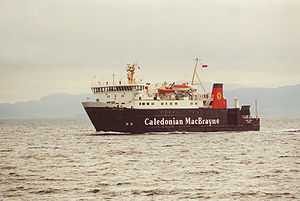MV Lord of the Isles
 MV Lord of the Isles in 2007 | |
| Name: | Lord of the Isles |
| Owner: | Caledonian Maritime Assets Limited |
| Operator: | Caledonian MacBrayne |
| Port of registry: |
Glasgow, |
| Route: |
Oban - Coll/Tiree/Barra/South Uist Oban - Colonsay (summer) Mallaig - South Uist (winter) |
| Builder: | Ferguson Shipbuilders, Port Glasgow |
| Launched: | 7 March 1989, the Clyde |
| Christened: | by Mrs Edith Rifkind, wife of Malcolm Rifkind Secretary of State for Transport |
| Maiden voyage: | 22 May 1989 |
| Identification: |
IMO number: 8710869[1]Callsign: MKHA7 MMSI number: 232605000 |
| Status: | in service |
| General characteristics | |
|---|---|
| Tonnage: | 3,504 |
| Length: | 84.6 m |
| Beam: | 15.8 m |
| Draft: | 3.18 m |
| Propulsion: | Diesel; 2 x Electric Bow Thrusters |
| Speed: | 16 knots (30 km/h; 18 mph) (service) |
| Capacity: | 506 passengers, 56 cars |
| Crew: | 28 |
| Notes: | [2] |
MV Lord of the Isles is one of the larger Caledonian Maritime Assets Limited ferries, run by Caledonian MacBrayne and operating from Oban on the west of Scotland. Built in Port Glasgow, she is the most-travelled vessel in today's fleet.
History
MV Lord of the Isles, affectionately known as LOTI,[3] was launched on the 7 March 1989 at Ferguson Shipbuilders, Port Glasgow. Although based at Oban for most of her life, she is able to berth and load traffic all over the Clyde and Hebridean Isles network.
Layout
At 85m long MV Lord of the Isles is one of the biggest ships in the fleet. Broadly similar to MV Isle of Mull at the forward end, while her aft end resembles that of MV Hebridean Isles. The car deck, open at the stern, is capable of holding up to 56 cars. She has a vehicle hoist to allow loading at the older piers.
The passenger accommodation provides space for a maximum certificate complement of 506. It consists of lounges, cafeteria, bar and shop on one deck, with an aft observation lounge on the deck above.[4] She is the last vessel in the fleet to have sleeping accommodation for the longer passages.[3]
Service
MV Lord of the Isles is based in Oban, Argyll. Entering service in 1989 on the Coll / Tiree and Barra / South Uist routes, she combined two previous timetables. This freed up both Columba (1964) and Claymore (1978) and allowed a cascade to take place within the fleet. She remained at Oban for nine years, occasionally switching places with MV Isle of Mull on the Craignure crossing and relieving at Uig and Ardrossan. In 1998 she was replaced by MV Clansman and transferred to Mallaig to replace the veteran MV Iona on the seasonal Skye service. During the winter months she returned to Oban in a relief role. Since 2003 she has been back at Oban, alongside Isle of Mull and Clansman, providing additional sailings to a wide range of routes. With seven islands appearing regularly in her routine, she is easily the most-travelled vessel in today's fleet.[4] In 2012 she served on the Ardrossan - Brodick Route and took over from MV Caledonian Isles when the usual vessel went for her overhaul. Since 2013 LOTI has carried out the Mallaig - Lochboisdale Winter trial service. The trial has proved unsuccessful with over half of the scheduled sailings cancelled due to adverse weather and tidal conditions.
See also
| Wikimedia Commons has media related to MV Lord of the Isles. |
Footnotes
- ↑ "Latest AIS for Lord of the Isles". ShipAIS. Retrieved 21 December 2009.
- ↑ "MV Lord of the Isles". Ships of Calmac.co.uk. Retrieved 7 January 2012.
- ↑ 3.0 3.1 Ian McCrorie. CalMac Ferries. CalMac. ISBN 0-9507166-7-7.
- ↑ 4.0 4.1 "History of MV Lord of the Isles". Ships of Calmac.co.uk. Retrieved 29 August 2007.